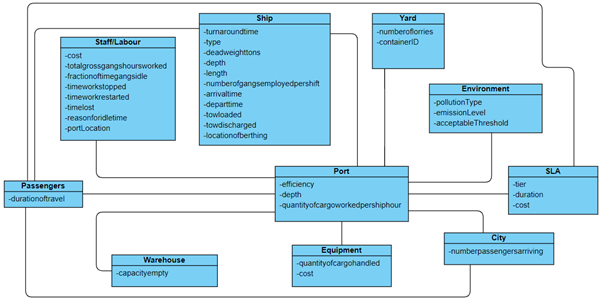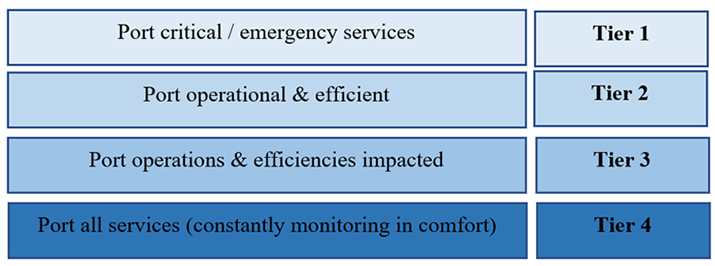Using an IoT Meta-model & Service Level Agreements to Support Automated Port Operations
This was influenced by growth in the global economy, a supply chain in favor of regionalized trade flow, rebalancing of the Chinese economy, technical advances, and more significant environmental situations [1] [2] promoting energy efficiency as a priority. The maritime industry has considered autonomous ships [2] [3] to respond to such problems, offering cost savings through reduced workforce and automated decision-making. During the Covid-19 pandemic, maritime priorities changed again [4], and the use of technology to support operations has moved to one concerned with the ability to accommodate flexible ship trade while dealing with shortages in containers, congested ports, and new lockdowns and border closures, in addition to seafarer safety [5]. While ship autonomy may go some way in supporting rapid reaction to international events, this technology is under-developed, and it introduces a host of challenges that remain to be solved [6]. Nonetheless, technology is a priority throughout a range of operations at and beyond ports, making this a growing research area [13].
Therefore, it is not surprising to identify research about flexible port pricing plans, as in [8] which recognizes that a competitive port is an attractive supply chain partner: Technology soaks up financial resources, both from the perspective of hardware through to the recruitment of staff skilled in operating them. However, although the authors of [8] examine the areas in which costs exist, they do not propose how flexible pricing may be exploited in support of agility. We recognize this gap in solutions and consider the opportunities to optimize maritime expenses by operating agilely. We propose using flexible and bespoke Service Levels Agreements (SLAs) at and beyond ports.
SLAs in this context refers to a guarantee of the collection of context data to support port operations in return for a charge. The SLA also supports the storage of collected data, processing, and alert generation on behalf of the port. How port operations need to be monitored varies depending on the user type. Therefore, cost-optimized SLAs can be offered by exploiting efficiencies when taking user types into account. As a result, we anticipate that operations and efficiencies at ports can be supported while also accommodating agile responses to change. Combined with this, the services can promote seafarer safety, efficient use of staff labor, and rapid identification of equipment degradation.
SLAs are currently offered in the maritime industry from perspectives that differ from that which we propose, including per-container solutions [8] and blockchain applications [9]. While these solutions are valuable, there is a gap in solutions that support people's existence and movement in and around ports, combined with a general inability to react in agile ways. It is, therefore, to this opportunity that our work seeks to contribute. Furthermore, we also consider the role of technology concerning tourism, specifically passengers that move through the port into neighboring regions. The services made available to and consumed by such individuals can be the subject of shorter-term SLAs than longer-term port SLAs. Finally, we will examine the application of this proposal within the context of Belfast Harbour [10].
Our proposal can collect a much broader range of data and amalgamate it to provide an overall, accurate, and consistent perspective of port activities. Data is fundamental to the maritime industry [10] [11] [12], and we propose that data relevant to a variety of maritime domains can be collected (Figure 1). These domains include safety [6], cybersecurity [14], supply chain data [1], tourism [16], environmental and sustainability factors [5], passenger-related data [15], automatic collection of port operations data from sensors [11], and cooperation with the port's host city [13].

Figure 1 Domains Supported by Proposed Port SLAs.
Supporting the operation of such an approach requires a meta-model specific to the port (Figure 2).

Figure 2 Context Data to Influence Port Service Level Agreements.
Once data has been collected, there are opportunities for its use to support bespoke, cost-efficient, and service-effective SLAs. We propose that this data is used to support service tiers (Figure 3). To explain its application: At a basic level (Tier 2 in Figure 3), a minimum of data will support efficient and operational operations and do not flag alerts. If an alert is flagged, data collection volume will increase, and increased observation will occur (Tier 3 in Figure 3).

Figure 3 Port SLA Service Tiers.
Supporting port SLAs, there is a need for data collection such that the bespoke agreements may be provisioned. The challenge of collecting data to support port operations was recognized in the Manual on Port Statistics (1987) [13]: As the maritime supply chain is an international endeavor, it may be assumed that data supporting operations at one port will similarly need to be collected to support operations at others. However, human skills across ports vary [2] [14 ] [15 ], particularly technical skills, and in developing countries, and we do not assume that ability to use technology and collected data will be available as consistently as needed. Therefore, the proposal of automated service provision and operations seeks to overcome such challenges.
References
- Review of Maritime Transport, 2019. Available at: https://unctad.org/system/files/official-document/rmt2019_en.pdf [Accessed 22 February 2022].
- Sustainable Shipping Homepage. Available at: https://www.sustainableshipping.org/ [Accessed 25 February 2022].
- Munim, Z. H. (2019) Autonomous ships: a review, innovative applications and future maritime business models, Supply Chain Forum: An International Journal, 20:4, 266-279, DOI: 10.1080/16258312.2019.1631714
- Review of Maritime Transport, 2021. https://unctad.org/webflyer/review-maritime-transport-2021 [Accessed 22 February 2022].
- Shan, D. (2021). Occupational health and safety challenges for maritime key workers in the global COVID‐19 pandemic. International Labour Review. 10.1111/ilr.12220.
- khoshalhan, F., Sayari, H., & Kalantari, T. (2020). A Model of fuzzy cognitive maps of the lean - agile Maritime supply chain. Journal of Marine Science and Technology, 19(1), 80-95. doi: 10.22113/jmst.2017.72353.1951
- Younis, Z. & Zeinab N. (2020) The Requirements of Agile Pricing Policies to Build a Competitive Maritime Sector: reflections on the Egyptian ports. The European Journal of Management EJM. ISSN: 1555-4015. The International Academy of Business and Economics.
- Maersk Homepage. Available at: maersk.com [Accessed: 25 February 2022].
- Czachorowski K., Solesvik M., & Kondratenko Y. (2019) The Application of Blockchain Technology in the Maritime Industry. In: Kharchenko V., Kondratenko Y., Kacprzyk J. (eds) Green IT Engineering: Social, Business and Industrial Applications. Studies in Systems, Decision and Control, vol 171. Springer, Cham. https://doi.org/10.1007/978-3-030-00253-4_24.
- Belfast Harbour Homepage. Available at: https://www.belfast-harbour.co.uk/ [Accessed 25 February 2022].
- United Nations Conference on Trade and Development (1976) Port Performance Indicators. Available at: https://unctad.org/system/files/official-document/tdbc4d131sup1rev1_en.pdf [Accessed 21 February 2022].
- Review of Maritime Transport 2020. https://unctad.org/webflyer/review-maritime-transport-2020 [Accessed 22 February 2022].
- United Nations Conference on Trade and Development (1987) Manual on a Uniform System of Port Statistics and Performance Indicators, 3rd Edition. Available at: https://unctad.org/system/files/official-document/shipd185rev2_en.pdf [Accessed 25 February 2022].
- Islam, S. & Olsen, T. (2011). Factors affecting seaport capacity. Proceedings of 19th International Congress on Modelling and Simulation, 412-418.
- OECD (2014) The Competitiveness of Global Port-Cities. OECD iLibrary, 1-272, DOI: 10.1787/9789264205277-en.
 Cathryn Peoples received a B.A. degree in business studies with computing, an M.Sc. degree in telecommunications and internet systems, and a Ph.D. degree in networking from Ulster University, U.K., in 2004, 2005, and 2009, respectively. She is currently employed as a Research Associate at Ulster University working on Service Level Agreements for the Internet of Things. Cathryn is also employed by The Open University in the School of Computing and Communications within the Faculty of Science, Technology, Engineering & Mathematics as an Associate Lecturer in Software Engineering. She became a member of IEEE in 2008, and an Editor-in-Chief of the EAI Endorsed Transactions on Cloud Systems in January 2020. Her research interests include cloud management, cross-layer protocol optimization, delay-tolerant networking, smart cities, and green IT.
Cathryn Peoples received a B.A. degree in business studies with computing, an M.Sc. degree in telecommunications and internet systems, and a Ph.D. degree in networking from Ulster University, U.K., in 2004, 2005, and 2009, respectively. She is currently employed as a Research Associate at Ulster University working on Service Level Agreements for the Internet of Things. Cathryn is also employed by The Open University in the School of Computing and Communications within the Faculty of Science, Technology, Engineering & Mathematics as an Associate Lecturer in Software Engineering. She became a member of IEEE in 2008, and an Editor-in-Chief of the EAI Endorsed Transactions on Cloud Systems in January 2020. Her research interests include cloud management, cross-layer protocol optimization, delay-tolerant networking, smart cities, and green IT.
 Adrian Moore is a Senior Lecturer in the School of Computing at Ulster University He has been at Ulster for over 35 years as undergraduate, postgraduate and member of academic staff. Adrian has a long track record of industrial collaboration in areas as diverse as television broadcast graphics, resource management, farm-to-diary milk collection management, course management software, cloud computing, software licencing analysis and software component integration. He is the author of “Multimedia Web Programming”, published by Palgrave Macmillan as well as many research papers in fields including Web technologies, computer graphics, network management, software engineering and computer architectures.
Adrian Moore is a Senior Lecturer in the School of Computing at Ulster University He has been at Ulster for over 35 years as undergraduate, postgraduate and member of academic staff. Adrian has a long track record of industrial collaboration in areas as diverse as television broadcast graphics, resource management, farm-to-diary milk collection management, course management software, cloud computing, software licencing analysis and software component integration. He is the author of “Multimedia Web Programming”, published by Palgrave Macmillan as well as many research papers in fields including Web technologies, computer graphics, network management, software engineering and computer architectures.
 Nektarios Georgalas works for British Telecom since 1998, currently a Principal Researcher in Applied Research. He leads innovation programmes with industrial and academic partners in IoT, Edge Computing, AI, Autonomics, Smart City, Mobility, Cloud, Data Centres and NFV/SDN. He led standards teams in TeleManagement Forum defining telecoms market strategy towards software-defined ecosystems of digital services in dynamic marketplaces and standardising key capabilities and APIs for Smart Cities. He received 20 international awards including IEEE Outstanding Leadership awards for IEEE Conferences General Co-chair, Programme Co-chair and keynote speaker service. He has 12 patents and has authored 70 papers.
Nektarios Georgalas works for British Telecom since 1998, currently a Principal Researcher in Applied Research. He leads innovation programmes with industrial and academic partners in IoT, Edge Computing, AI, Autonomics, Smart City, Mobility, Cloud, Data Centres and NFV/SDN. He led standards teams in TeleManagement Forum defining telecoms market strategy towards software-defined ecosystems of digital services in dynamic marketplaces and standardising key capabilities and APIs for Smart Cities. He received 20 international awards including IEEE Outstanding Leadership awards for IEEE Conferences General Co-chair, Programme Co-chair and keynote speaker service. He has 12 patents and has authored 70 papers.
Sign Up for IoT Technical Community Updates
Calendar of Events
IEEE 8th World Forum on Internet of Things (WF-IoT) 2022
26 October-11 November 2022
Call for Papers
IEEE Internet of Things Journal
Special issue on Towards Intelligence for Space-Air-Ground Integrated Internet of Things
Submission Deadline: 1 November 2022
Special issue on Smart Blockchain for IoT Trust, Security and Privacy
Submission Deadline: 15 November 2022
Past Issues
September 2022
July 2022
March 2022
January 2022
November 2021
September 2021
July 2021
May 2021
March 2021
January 2021
November 2020
July 2020
May 2020
March 2020
January 2020
November 2019
September 2019
July 2019
May 2019
March 2019
January 2019
November 2018
September 2018
July 2018
May 2018
March 2018
January 2018
November 2017
September 2017
July 2017
May 2017
March 2017
January 2017
November 2016
September 2016
July 2016
May 2016
March 2016
January 2016
November 2015
September 2015
July 2015
May 2015
March 2015
January 2015
November 2014
September 2014


